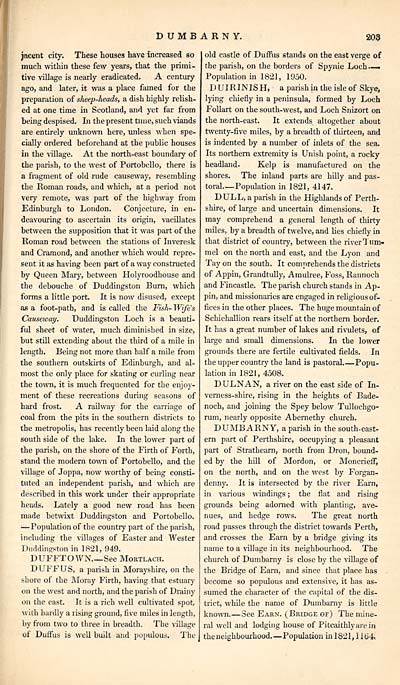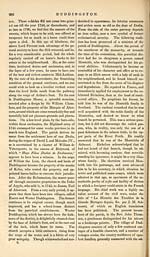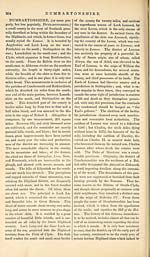Gazetteer of Scotland > Volume 1
(231) Page 203
Download files
Complete book:
Individual page:
Thumbnail gallery: Grid view | List view

DUMBARNY.
203
jacent city. These houses have increased so
much within these few years, that the primi-
tive village is nearly eradicated. A century
ago, and later, it was a place famed for the
preparation of sheep-heads, a dish highly relish-
ed at one time in Scotland, and yet far from
being despised. In the present time, such viands
are entirely unknown here, unless when spe-
cially ordered beforehand at the public houses
in the village. At the north-east boundary of
the parish, to the west of Portobello, there is
a fragment of old rude causeway, resembling
the Roman roads, and which, at a period not
very remote, was part of the highway from
Edinburgh to London. Conjecture, in en-
deavouring to ascertain its origin, vacillates
between the supposition that it was part of the
Roman road between the stations of Inveresk
and Cramond, and another which would repre-
sent it as having been part of a way constructed
by Queen Mary, between Holyroodhouse and
the debouche of Duddingston Burn, which
forms a little port. It is now disused, except
as a foot-path, and is called the Fish- Wife's
Causeway. Duddingston Loch is a beauti-
ful sheet of water, much diminished in size,
but still extending about the third of a mile in
length. Being not more than half a mile from
the southern outskirts of Edinburgh, and al-
most the only place for skating or curling near
the town, it is much frequented for the enjoy-
ment of these recreations during seasons of
hard frost. A railway for the carriage of
coal from the pits in the southern districts to
the metropolis, has recently been laid along the
south side of the lake. In the lower part of
the parish, on the shore of the Firth of Forth,
stand the modern town of Portobello, and the
village of Joppa, now worthy of being consti-
tuted an independent parish, and which are
described in this work under their appropriate
heads. Lately a good new road has been
made betwixt Duddingston and Portobello.
— Population of the country part of the parish,
including the villages of Easter and Wester
Duddingston in 1821, 949.
DUFFTOWN.— See Mortlach.
DUFF US, a parish in Morayshire, on the
shore of the Moray Firth, having that estuary
on the west and north, and the parish of Drainy
on the east. It is a rich well cultivated spot,
with hardly a rising ground, five miles in length,
by from two to three in breadth. The village
of Duffus is well built and populous. The
old castle of Duffus stands on the east verge of
the parish, on the borders of Spynie Loch—.
Popidation in 1821, 1950.
DUIRINISH, a parishin the isleof Skye,
lying chiefly in a peninsula, formed by Loch
Follart on the south-west, and Loch Snizort on
the north-east. It extends altogether about
twenty-five miles, by a breadth of thirteen, and
is indented by a number of inlets of the sea.
Its northern extremity is Unish point, a rocky
headland. Kelp is manufactured on the
shores. The inland parts are hilly and pas-
toral — Population in 1821, 4147.
DULL, a parish in the Highlands of Perth-
shire, of large and uncertain dimensions. It
may comprehend a general length of thirty
miles, by a breadth of twelve, and lies chiefly in
that district of country, between the river Tum-
mel on the north and east, and the Lyon and
Tay on the south. It comprehends the districts
of Appin, Grandtully, Amulree, Foss, Rannoch
and Fincastle. The parish church stands in Ap-
pin, and missionaries are engaged in religious of-
fices in the other places. The huge mountain of
Schiehallion rears itself at the northern border.
It has a great number of lakes and rivulets, of
large and small dimensions. In the lower
grounds there are fertile cultivated fields. In
the upper country the land is pastoral Popu-
lation in 1821, 4508.
DULNAN, a river on the east side of In-
verness-shire, rising in the heights of Bade-
noch, and joining the Spey below Tullochgo-
rum, nearly opposite Abernethy church.
DUMBARNY, a parish in the south-east-
ern part of Perthshire, occupying a pleasant
part of Strathearn, north from Dron, bound-
ed by the hill of Mordon, or Moncrieff,
on the north, and on the west by Forgan-
denny. It is intersected by the river Earn,
in various windings ; the flat and rising
grounds being adorned with planting, ave-
nues, and hedge rows. The great north
road passes through the district towards Perth,
and crosses the Earn by a bridge giving its
name to a village in its neighbourhood. The
church of Dumbarny is close by the village of
the Bridge of Earn, and since that place has
become so popidous and extensive, it has as-
sumed the character of the capital of the dis-
trict, while the name of Dumbarny is little
known. — See Earn. (Bridge of) The mine-
ral well and lodging house of Pitcaithlyaiein
the neighbourhood. — Population in 1821, 1164,
203
jacent city. These houses have increased so
much within these few years, that the primi-
tive village is nearly eradicated. A century
ago, and later, it was a place famed for the
preparation of sheep-heads, a dish highly relish-
ed at one time in Scotland, and yet far from
being despised. In the present time, such viands
are entirely unknown here, unless when spe-
cially ordered beforehand at the public houses
in the village. At the north-east boundary of
the parish, to the west of Portobello, there is
a fragment of old rude causeway, resembling
the Roman roads, and which, at a period not
very remote, was part of the highway from
Edinburgh to London. Conjecture, in en-
deavouring to ascertain its origin, vacillates
between the supposition that it was part of the
Roman road between the stations of Inveresk
and Cramond, and another which would repre-
sent it as having been part of a way constructed
by Queen Mary, between Holyroodhouse and
the debouche of Duddingston Burn, which
forms a little port. It is now disused, except
as a foot-path, and is called the Fish- Wife's
Causeway. Duddingston Loch is a beauti-
ful sheet of water, much diminished in size,
but still extending about the third of a mile in
length. Being not more than half a mile from
the southern outskirts of Edinburgh, and al-
most the only place for skating or curling near
the town, it is much frequented for the enjoy-
ment of these recreations during seasons of
hard frost. A railway for the carriage of
coal from the pits in the southern districts to
the metropolis, has recently been laid along the
south side of the lake. In the lower part of
the parish, on the shore of the Firth of Forth,
stand the modern town of Portobello, and the
village of Joppa, now worthy of being consti-
tuted an independent parish, and which are
described in this work under their appropriate
heads. Lately a good new road has been
made betwixt Duddingston and Portobello.
— Population of the country part of the parish,
including the villages of Easter and Wester
Duddingston in 1821, 949.
DUFFTOWN.— See Mortlach.
DUFF US, a parish in Morayshire, on the
shore of the Moray Firth, having that estuary
on the west and north, and the parish of Drainy
on the east. It is a rich well cultivated spot,
with hardly a rising ground, five miles in length,
by from two to three in breadth. The village
of Duffus is well built and populous. The
old castle of Duffus stands on the east verge of
the parish, on the borders of Spynie Loch—.
Popidation in 1821, 1950.
DUIRINISH, a parishin the isleof Skye,
lying chiefly in a peninsula, formed by Loch
Follart on the south-west, and Loch Snizort on
the north-east. It extends altogether about
twenty-five miles, by a breadth of thirteen, and
is indented by a number of inlets of the sea.
Its northern extremity is Unish point, a rocky
headland. Kelp is manufactured on the
shores. The inland parts are hilly and pas-
toral — Population in 1821, 4147.
DULL, a parish in the Highlands of Perth-
shire, of large and uncertain dimensions. It
may comprehend a general length of thirty
miles, by a breadth of twelve, and lies chiefly in
that district of country, between the river Tum-
mel on the north and east, and the Lyon and
Tay on the south. It comprehends the districts
of Appin, Grandtully, Amulree, Foss, Rannoch
and Fincastle. The parish church stands in Ap-
pin, and missionaries are engaged in religious of-
fices in the other places. The huge mountain of
Schiehallion rears itself at the northern border.
It has a great number of lakes and rivulets, of
large and small dimensions. In the lower
grounds there are fertile cultivated fields. In
the upper country the land is pastoral Popu-
lation in 1821, 4508.
DULNAN, a river on the east side of In-
verness-shire, rising in the heights of Bade-
noch, and joining the Spey below Tullochgo-
rum, nearly opposite Abernethy church.
DUMBARNY, a parish in the south-east-
ern part of Perthshire, occupying a pleasant
part of Strathearn, north from Dron, bound-
ed by the hill of Mordon, or Moncrieff,
on the north, and on the west by Forgan-
denny. It is intersected by the river Earn,
in various windings ; the flat and rising
grounds being adorned with planting, ave-
nues, and hedge rows. The great north
road passes through the district towards Perth,
and crosses the Earn by a bridge giving its
name to a village in its neighbourhood. The
church of Dumbarny is close by the village of
the Bridge of Earn, and since that place has
become so popidous and extensive, it has as-
sumed the character of the capital of the dis-
trict, while the name of Dumbarny is little
known. — See Earn. (Bridge of) The mine-
ral well and lodging house of Pitcaithlyaiein
the neighbourhood. — Population in 1821, 1164,
Set display mode to: Large image | Transcription
Images and transcriptions on this page, including medium image downloads, may be used under the Creative Commons Attribution 4.0 International Licence unless otherwise stated. ![]()
| Gazetteers of Scotland, 1803-1901 > Gazetteer of Scotland > Volume 1 > (231) Page 203 |
|---|
| Permanent URL | https://digital.nls.uk/97427134 |
|---|
| Description | Volume I: Abbey to Glenartney. |
|---|---|
| Attribution and copyright: |
|
| Description | By Robert Chambers and William Chambers. Glasgow: Blackie & Son, 1838. 2 volumes. |
|---|---|
| Shelfmark | NF.1461.g.7 |
| Additional NLS resources: | |

